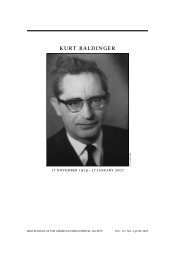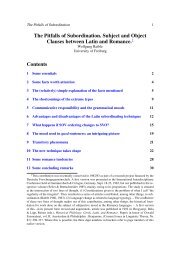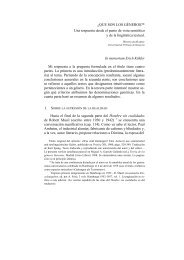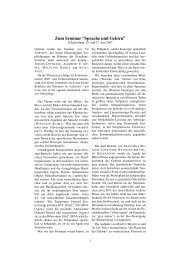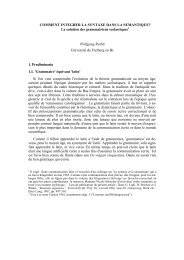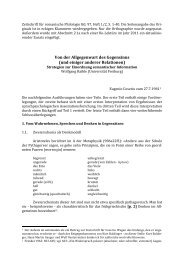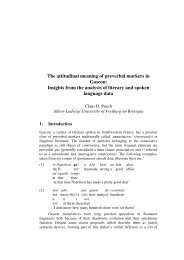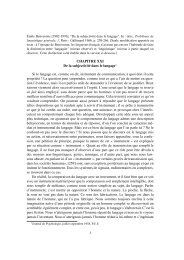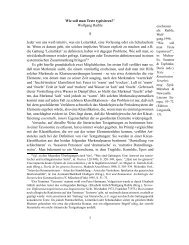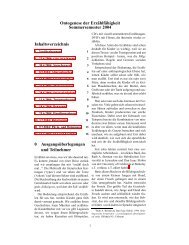A Summary of Role and Reference Grammar
A Summary of Role and Reference Grammar
A Summary of Role and Reference Grammar
Create successful ePaper yourself
Turn your PDF publications into a flip-book with our unique Google optimized e-Paper software.
The lexicon<br />
The lexicon plays a very important role in RRG, <strong>and</strong> it should be considered a lexicalist theory.<br />
Lexical entries for verbs are built around LSs; the lexical representation <strong>of</strong> nouns is based<br />
on the theory <strong>of</strong> nominal qualia proposed in Pustejovsky (1995). RRG takes the position that<br />
lexical entries for verbs should contain only idiosyncratic information, with as much as possible<br />
derived from general lexical principles or rules. Information about transitivity is very important,<br />
<strong>and</strong> RRG defines transitivity in terms <strong>of</strong> the number <strong>of</strong> macroroles that a verb takes (Narasimhan<br />
1998): M[acrorole]-transitive = 2, M-intransitive = 1, M-atransitive = 0. In RRG, no syntactic<br />
subcategorization information is included in lexical entries; all <strong>of</strong> the relevant information is derivable<br />
from the LS <strong>of</strong> the verb plus information about its transitivity. Thus these principles have<br />
the effect <strong>of</strong> predicting the syntactic subcategorization <strong>of</strong> a verb from its semantic representation.<br />
All theories must specify the transitivity <strong>of</strong> exceptional verbs, <strong>and</strong> this is done in RRG by specifying<br />
their M-transitivity in terms <strong>of</strong> [MRα], where ‘α’ is 0, 1 or 2. Sample lexical entries for<br />
some English verbs are given in (15).<br />
(15) a. kill [do´ (x, Ø)] CAUSE [BECOME dead´ (y)]<br />
b. own have´ (x, y)<br />
c. belong (to) have´ (x, y) [MR1]<br />
d. put [do´ (w, Ø)] CAUSE [BECOME be-LOC´ (x,y)]<br />
e. seem seem´ (x,y) [MR0]<br />
f. see see´ (x,y)<br />
g. watch do´ (x, [see´ (x,y)])<br />
h. show [do´ (w, Ø)] CAUSE [BECOME see´ (x,y)]<br />
i. run do´ (x, [run´ (x)])<br />
j. melt BECOME melted´ (x)<br />
The prepositions that mark oblique core arguments can in many instances be predicted from the<br />
LS <strong>of</strong> the verb <strong>and</strong> therefore need not be listed in the lexical entry (cf. Jolly 1993, Van Valin &<br />
LaPolla 1997).<br />
RRG distinguishes lexical from syntactic phenomena in terms <strong>of</strong> the linking scheme (see<br />
below). Basically, any process which affects LSs or the arguments therein or the mapping between<br />
LSs <strong>and</strong> macroroles is considered to be lexical. Examples include causativization, regardless<br />
<strong>of</strong> whether it is morphologically unmarked (as in English) or marked (as in Japanese<br />
<strong>and</strong> Lakhota), noun incorporation, the ‘dative alternation’ (which is analyzed as variable linking<br />
to undergoer; cf. Van Valin 1993a, 2005), <strong>and</strong> some types <strong>of</strong> passivization <strong>and</strong> antipassivization.<br />
Syntactic phenomena involve the mapping between macroroles <strong>and</strong> the syntactic representation,<br />
e.g. some types <strong>of</strong> passivization <strong>and</strong> antipassivization, WH-question formation in languages like<br />
English <strong>and</strong> Icel<strong>and</strong>ic, <strong>and</strong> ‘raising’ constructions (cf. Van Valin 2005).<br />
The semantics <strong>of</strong> clause linkage<br />
The syntactic clause-linkage relations discussed earlier are used to express certain semantic<br />
relations between the units in the linkage, e.g. causation, purpose, <strong>and</strong> temporal sequence. The<br />
interclausal semantic relations are given in (16).<br />
17



